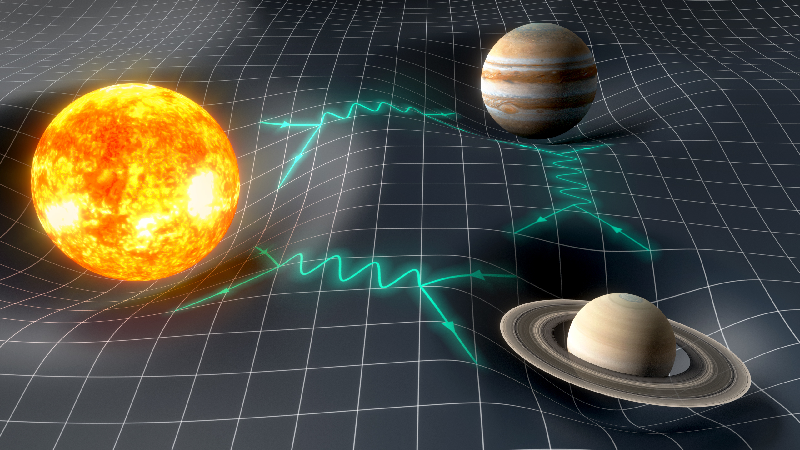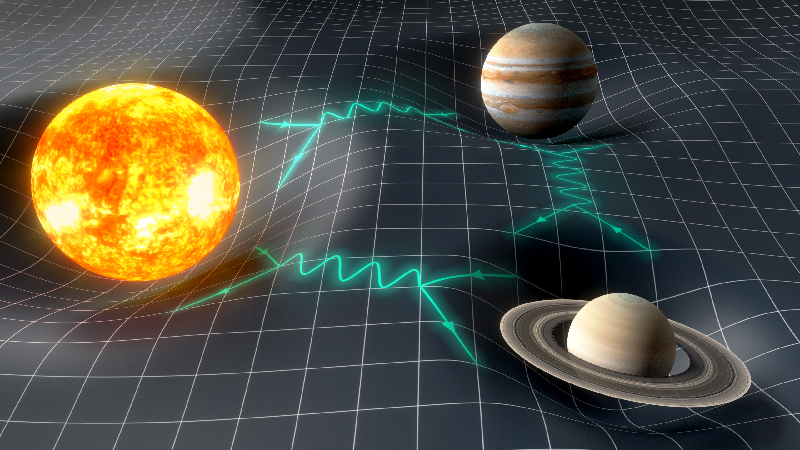Limits on the Graviton from Planetary Orbits
The force of gravity, explained using Einstein’s general theory of relativity, can be associated with a particle called the graviton that is thought to have zero mass. One way to check if the particle is really massless is to calculate an upper limit on its mass from detailed observations of planetary motions in the Solar System. Now a team has improved upon a previous effort to do this by avoiding a hidden assumption in the earlier work. Any sign that the mass might not be zero could suggest that new theories beyond general relativity are required.
Since the gravitational force is thought to travel at the speed of light, the graviton mass mg should be zero; only massless objects like the photon can move that fast. But if the graviton has a small but nonzero mass, gravity would have a finite rather than infinite range, characterized by the graviton’s so-called Compton wavelength 𝜆g. Observations of gravitational waves have indicated that mg is smaller than 5×10−23 eV [1, 2], with a corresponding 𝜆g value of at least 2.6×1013 km.
Cosmological considerations—for example, how a finite 𝜆g would change the expansion of the Universe—can constrain mg considerably more tightly than gravitational-wave observations (to about 10−32 eV). But physicists are keen to find independent ways of estimating this bound. About two decades ago, Clifford Will, now at the University of Florida in Gainesville, suggested that limits on mg might also be deduced by looking at the motions of bodies in the Solar System [3], because a massive graviton would create deviations from the predictions of general relativity.
Recently Will applied this approach to observations of Mars’s orbit and calculated an upper limit on mg of between 5.6×10−24 and 10−23eV [4]. Now Leo Bernus of the Paris Observatory and coworkers have done a similar study but in a way that avoids a hidden assumption, and they have included many more Solar-System objects in their analysis.
Before comparing general relativity’s predictions for planetary orbits with observations, you need to know the planets’ initial positions at some given time, as well as the masses. Researchers must obtain these parameters by fitting an orbital model to the observational data. But if this fitting procedure does not admit the possibility of a massive graviton, then the parameters obtained will contain a bias toward standard relativity. To allow for a theory with a massive graviton, 𝜆g needs to be added as an adjustable parameter in the initial fitting procedure for determining the masses and other starting parameters, Bernus says.
In their new analysis, Bernus and his colleagues predict planetary positions at some time after, and before, their initial conditions using a Solar-System model called INPOP17b [5]. The team started with the positions, masses, and speeds of the Sun, planets, moons, and many asteroids as derived from a fit that allowed for a finite 𝜆g performed on measurements from 2000. They then ran the INPOP17b equations of motion backward and forward in time, to 1913 and 2017, respectively, the period over which good observational data exist. The researchers then looked for any differences with observations that might hint at a massive graviton.
The results indicate that 𝜆g cannot be less than 1.83×1013 km, and thus mg cannot be more than 6.76×10−23 eV, with 90% confidence. These values differ from Will’s by nearly a factor of 10 but are very close to those obtained from gravitational-wave studies, despite being derived by a completely independent route—a finding that Bernus says is pure coincidence. He adds that, as still better data on Solar System motions become available, this constraint will get ever tighter.
Astrophysicist Nicolas Yunes of the University of Illinois at Urbana-Champaign agrees with Bernus and his colleagues that, because of the hidden assumption, Will’s constraints on mg were “perhaps stronger than they should have been.” Will welcomes the new result. “I was aware that a fuller analysis could give a weaker bound, and part of my motivation was to inspire [others] to carry out such a full ephemeris analysis,” he says. Will is disappointed that the new bound is weaker than his, "but that’s life,” he says.
This research is published in Physical Review Letters.
Correction (22 October 2019): The headline was updated to say "graviton" instead of "quantum gravity" because the graviton is not necessarily associated with quantum gravity.
–Philip Ball
Philip Ball is a freelance science writer in London. His latest book is How Life Works (Picador, 2024).
References
- B. P. Abbott et al., “GWTC-1: A gravitational-wave transient catalog of compact binary mergers observed by LIGO and Virgo during the first and second observing runs,” Phys. Rev. X 9, 031040 (2019).
- B.P. Abbott et al. (LIGO Scientific Collaboration and Virgo Collaboration), “Tests of general relativity with the binary black hole signals from the LIGO-Virgo catalog GWTC-1,” arXiv:1903.04467.
- C.M. Will, “Bounding the mass of the graviton using gravitational-wave observations of inspiralling compact binaries,” Phys. Rev. D 57, 2061 (1998).
- C.M. Will, “Solar system versus gravitational-wave bounds on the graviton mass,” Class. Quantum Grav. 35, 17LT01 (2018).
- A. Fienga, H. Manche, J. Laskar, and M. Gastineau, “INPOP06: a new numerical planetary ephemeris,” Astron. Astrophys. 477, 315 (2007).





